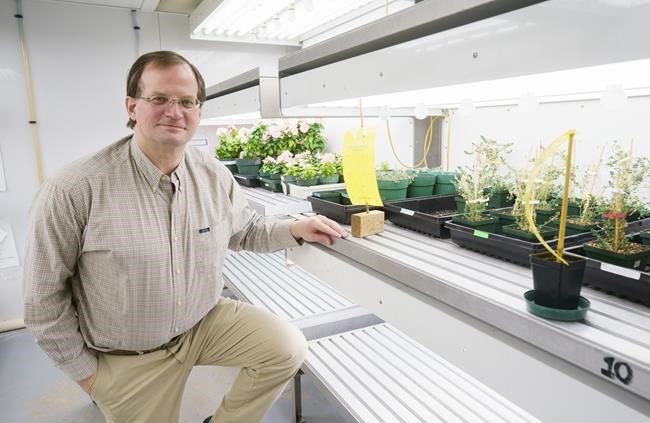So it's lunchtime on Day 800 of your three-year trip to Mars and, as you hurtle through space, you and three fellow astronauts sit down for a bite.
What's on the menu?
Could be a protein shake from algae grown on near-waterless biofilms. Maybe a tasty spread made from crickets, with a few mini-greenhouse strawberries on the side. How about some "scrambled eggs," processed from microbes, together with a slice or two of "space bacon," a.k.a. mushroom mycelia?
Those are all suggestions from 10 Canadian semifinalists in the Deep Space Food Challenge, co-sponsored by NASA and the Canadian Space Agency.
"We can only go as far as we can feed the astronauts," said Clelia Cothier, who's managing the contest for the Canadian agency.
She said semifinalists each get $30,000 to contribute to the next stage of their project, which will be to build a working model of their proposal by January 2023, with a winner to be announced in the spring of 2024.
The rules are daunting. The winning system must help feed four astronauts on a three-year mission with no resupply, use a space about the size of a refrigerator, with strict weight and power limits, and "create a variety of palatable, nutritious, and safe foods that require little processing time."
Algae are the answer, say several contestants.
"I compare algae to 3D printers," said Soheyl Mottahedeh of AlgaBloom International, which proposes a light-powered "bioreactor" to grow specific types of algae. "You have the possibility to produce any of the ingredients of planet Earth."
Using nutrients from urine and water from fuel combustion, Mottahedeh said his system can easily produce drinks, noodles, chips or a yogurt-like paste that contains all the minerals and vitamins hard-working astronauts need. No carbohydrates, though.
Such systems are easy to use, said Valerie Ward of the University of Waterloo, another contestant. You just squeegee the algae off the host surface every couple days.
Her system, she said, produces about 20 per cent of the food that four crew members would need.
"It tastes kind of like spinach. It's very nutritious."
Microbes, anyone? Contestant Noblegen is already marketing products derived from Euglena, a microscopic beastie that's part plant, part animal.
Euglena turns waste into a yellow-green paste or "liquid gold," said Noblegen director Scott Farrow.
"It's not only packed with protein, it makes some very healthy lipids."
Noblegen is trying to turn Euglena into analogues for pulled pork, tuna salad or scrambled eggs. The eggs are coming along, but the products are all works in progress.
"Texture, taste and smell — everybody struggles with that," Farrow said.
Several contestants are working with bugs.
Students at McGill University are using crickets to recycle waste, such as used clothing or paper, into food that could be mixed into a drink or blended into other foods.
Taste tests are down the road, said faculty supervisor Mark Lefsrud.
"Astronauts have to want to eat it."
Leonard Audibert of Canacompost Systems is using black soldier flies to reuse and "upcycle" waste.
"The cool thing about insects is you can make a lot of them."
He said flies could generate compost to help make Martian soil fertile. The flies could feed chickens or fish or even be ground up for humans — although he said flies aren't yet approved for human consumption.
Some contestants are working with plants.
Ecoation is developing modular, mini-greenhouses that can produce fresh food including strawberries or tomatoes. The company is making "space bacon" out of the compressed and flavoured mycellia of mushrooms.
"It has kind of a chewy texture and is quite similar to bacon," said company spokesman Gavin Schneider.
PeaPod Technologies is using similar-sized greenhouses together with a system that applies water and nutrients directly to a plant's roots, said founder Jayden Lefebvre. Miniature potatoes, with this method, could produce up to 2,000 calories a day, he said.
It might also have an appeal lacking in pastes, powders and pills.
"We're focusing on fresh foods, lots of crop variety," Lefebvre said. "We chose to focus on the human aspect of flavour and things like that."
Cothier said the contest — as well as associated workshops and other events for competitors — helps spur research and build a community of Canadian experts in a growing field.
"That's the whole point," she said. "The idea is to encourage companies and help them grow as a cohort."
Association with space travel gives the contest a certain glamour, but contestants said they want their work to extend agriculture on Spaceship Earth. Food systems adapted to the harsh conditions of space could also improve food security in places like deserts or the Arctic, where traditional agriculture doesn't work.
"Even if we don't make it to the next phase, I see our project as continuing," said Audibert. "There are some really cool Earth applications.
"We can feed people."
That's the goal, agreed Lefebvre.
"Anything that's good for space is going to be great for Earth."
This report by The Canadian Press was first published Dec. 12, 2021.
— Follow Bob Weber on Twitter at @row1960
Bob Weber, The Canadian Press




